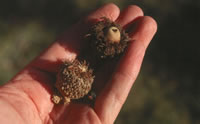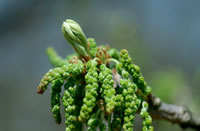Bur Oak: A Tree for Utah
by Michael Kuhns, Extension Forestry Specialist
Many tree people regret the fact that there are few good oak species suitable for planting in Utah landscapes. Pin oak and, to some extent, northern red oak suffer from iron chlorosis and other problems. Native Gambel oaks do well but are shrubby and have limited usefulness in the landscape. Most other oaks commonly planted in other parts of the country are not well-adapted to Utah's climate and soils. There is one oak, however, that is well-adapted to many areas in Utah--the bur oak.
Natural Characteristics
Bur oak (Quercus macrocarpa) is a widely adapted species that is native throughout the eastern U.S. and as far west as eastern Montana and Wyoming. It ranges from southern Texas to southern Manitoba. Bur oak grows both on moist, bottomland sites and on dry, upland sites. It grows naturally in areas with precipitation ranging from 15 inches to 50 inches annually, and with a growing season ranging from 100 days up to 260 days. Though it likes acid soils, it is also tolerant of fairly alkaline (high pH) soils.
In many places bur oak actually forms the edge between eastern hardwood forests and the prairie. As might be expected from a tree that grows on such sites, bur oak is very drought resistant and has thick, fire-resistant bark when old. It also has a deep, spreading root system that is able to take advantage of limited soil moisture. A mature bur oak on a dry, well-drained site in Nebraska was found to have a root system that extended at least 16 feet deep and 72 feet laterally. On the other hand, bur oak is often found in mixed-species stands in rich, moist soils on bottomland sites. Its intermediate shade tolerance allows it to compete successfully in such stands, though it is eventually replaced by more shade tolerant species like maples.
Though naturally a fairly slow growing tree, bur oak can get quite large, reaching a maximum height of 170 feet and trunk diameter of 84 inches in the Ohio Valley. Heights of 80 to 100 feet and diameters of 36 to 48 inches are common on good sites. Annual height growth commonly reaches one foot and annual diameter growth one-tenth to one-quarter of an inch. However, a study of ten seed sources collected from Texas to New York and grown in eastern Nebraska showed seedling annual height growth of up to two feet and annual diameter growth of up to one-third of an inch during a drought without irrigation or fertilization.
Bur oak is named for its acorn's bur-like fringed cap. The acorn can get quite large depending on the geographic location of the tree, with more southern sources having larger acorns. Bur oak acorns from Texas sources can be 1-1/2 to 2 inches long. The acorns are valuable food for wildlife.
Bur oak is relatively free of severe insect and disease problems. It is fairly tolerant of soil compaction, though severe compaction will weaken its root system and make it more susceptible to other problems. Bur oak does not tolerate flooding or saturated soils well. As mentioned earlier, bur oak is very drought tolerant. Bur oak also tolerates urban pollution well. Its tolerance of harsh conditions and many types of stresses makes bur oak a very long-lived tree, and ages of several hundred years are not uncommon.
Landscape Use in Utah
Great variability and adaptability to a wide variety of sites, including some very harsh sites, makes bur oak a good species to plant in landscapes in much of Utah. Established trees that are doing well can be found in many locations. Tolerance of drought, pollution, and soil compaction makes it a good tree for urban and suburban conditions. Natural precipitation should give it enough moisture to survive, once established, in many parts of the state. Irrigation may be needed where precipitation drops below 15 inches a year, and will increase growth and vigor even on moister sites.
Bur oak should be planted in full to nearly full sun in a well-drained soil, though it is tolerant of a wide range of soil conditions including heavy clay. Very high soil pH (above 7.5 to 8), as found in many areas in Utah, may cause some iron chlorosis problems. Such pH levels are found in the species' natural range, however, so these problems should be minimal on all but the worst sites. Bur oak is difficult to transplant, possibly because of the loss of many of its deep roots during digging. Transplanting success is generally better with younger trees where most of the roots can be dug and moved.
Its eventual large size make bur oak a good tree for parks and other large open areas, as well as medium to large residential yards. In Utah bur oak will probably not get as large as it does on good native sites, but its growth rate and size should be adequate. An eventual height of 60 to 70 feet can be expected for well tended trees on good sites in Utah, with a similar crown spread. The wide crown typically has many strong branches with a somewhat conical form when young and a rounded or flat-topped form on older trees.
Seed source or geographic origin may be an important consideration when planting bur oak, but named varieties are uncommon and little is known about the adaptability of various sources to Utah locales. Southern sources can be expected to grow faster than northern sources, but will not be as cold hardy or drought resistant. Sources from the central Great Plains are likely to give the best combination of good growth and stress tolerance. Northeastern U.S. sources should be cold tolerant but will grow slower and may not be quite as drought tolerant as Midwest sources.
Bur oak's slow growth may be considered a negative feature by many. Too often, however, we focus our efforts on planting trees that will grow quickly without considering the future. Many fast growing species like cottonwood and silver maple become too large for their site, are weak wooded, and are short lived. Bur oak, on the other hand, grows much slower but is a strong tree that can live for generations. Therefore, though a few silver maples and cottonwoods should be planted for the short term, bur oaks and other such trees should be planted to form the backbone of our future landscape.






